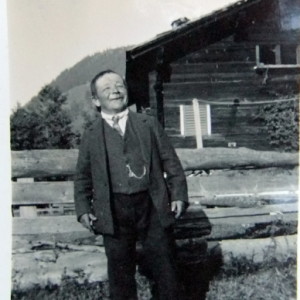Martin le crétin
Switzerland 1927. The Old Man (who died two months ago) was 6 years old and visiting relations with his parents. In this photo he's sitting with his mother and pointing at Martin who was, yes, a cretin.
Of course we wouldn't use that term today since it has acquired such derogatory connotations but back in the day it was the accepted name for the many, many such unfortunate inhabitants of Switzerland's landlocked valleys. Physically stunted and mentally compromised, often with huge goitres (swellings around the neck) such individuals were a common sight and by all accounts were tolerated as harmless 'creatures of God'. They were recorded from antiquity, not only in Switzerland but in other inland areas far from the sea the world over. In Britain goitre was known as Derbyshire neck. It's thought that Frans Hals' 17th century painting of Malle Babbe may represent a cretin. But it was the deep Alpine valleys that were the most notorious for the affliction. Mark Twain wrote on a visit in 1880
'I am satisfied. I have seen the principal features of Swiss scenery —Mount Blanc and the goiter— and now for home.'
In 1840 a Swiss doctor called Louis Guggenbuhl was inspired to try and treat the condition. He raised money, much of it his own, to establish a fine sanatorium where he offered a combination of therapies: physical exercise, massage, personal care, a nutritious diet and intensive training to develop all the senses. He persisted for 17 years and drew much interest and admiration from the wider world, but although he clearly improved the lives of his patients he could not cure them. It was not until the early 20th century that endocrinologists confirmed that cretinism was the result of congenital hypothyroidism caused by lack of iodine in the diet and the environment (although curiously-enough, iodine-rich seaweed and sponges had long been a traditional remedy for goitre.) Henceforward household salt has been iodised in Switzerland and all other developed countries alhtough the condition still occurs in the mountainous inland regions of the world that lack a public health care system organised to prevent it. It was a major problem in China until relatively recently, and this article describes the effects of thyroid insufficiency elsewhere in the world including the USA.
I don't know whether Martin ever received any treatment (although the condition is not reversible beyond infancy) but he lived on in his small community into the 1950s and loved to dance. As the extra image shows, he seemed cheerful and could look very smartly turned-out. He was one of the lucky ones.


Comments
Sign in or get an account to comment.


